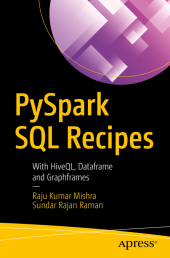 Neuerscheinungen 2019Stand: 2020-02-01 |
Schnellsuche
ISBN/Stichwort/Autor
|
Herderstraße 10
10625 Berlin
Tel.: 030 315 714 16
Fax 030 315 714 14
info@buchspektrum.de |

Raju Kumar Mishra
PySpark SQL Recipes
With HiveQL, Dataframe and Graphframes
1st ed. 2019. xxiv, 323 S. 57 SW-Abb. 235 mm
Verlag/Jahr: SPRINGER, BERLIN; APRESS 2019
ISBN: 1-484-24334-X (148424334X)
Neue ISBN: 978-1-484-24334-3 (9781484243343)
Preis und Lieferzeit: Bitte klicken
Carry out data analysis with PySpark SQL, graphframes, and graph data processing using a problem-solution approach. This book provides solutions to problems related to dataframes, data manipulation summarization, and exploratory analysis. You will improve your skills in graph data analysis using graphframes and see how to optimize your PySpark SQL code.
PySpark SQL Recipes starts with recipes on creating dataframes from different types of data source, data aggregation and summarization, and exploratory data analysis using PySpark SQL. You´ll also discover how to solve problems in graph analysis using graphframes.
On completing this book, you´ll have ready-made code for all your PySpark SQL tasks, including creating dataframes using data from different file formats as well as from SQL or NoSQL databases.
What You Will Learn
Understand PySpark SQL and its advanced features
Use SQL and HiveQL with PySpark SQL
Work with structured streaming
Optimize PySpark SQL
Master graphframes and graph processing
Who This Book Is For Data scientists, Python programmers, and SQL programmers.
Chapter 1: Introduction to PySparkSQL
Chapter Goal: Reader will understand about PySpark, PySparkSQL , Catalyst Optimizer, Project Tungsten and Hive
No of pages 20-30
Sub -Topics
1. PySpark
2. PySparkSQL
3. Hive
4. Catalyst
5. Project Tungsten
Chapter 2: Some time with Installation
Chapter Goal: Learner will understand about installation of Spark, Hive, PostgreSQL, MySQL, MongoDB, Cassandra etc.
No of pages: 30 -40
Sub - Topics
1. Installation Spark
2. Installation Hive
3. Installation MySQL
4. Installation MongoDB
Chapter 3: IO in PySparkSQL
Chapter Goal: This chapter will provide recipes to the reader, which will enable them to create PySparkSQL DataFrame from different sources.
No of pages : 40-50
Sub - Topics:
1. Creating DataFrame from data.
2. Reading csv file to create Dataframe
3. Reading JSON file to create Dataframe.
4. Saving DataFrames to different formats.
Chapter 4 : Operations on PySparkSQL DataFrames
Chapter Goal: Reader will learn about data filtering, data manuipulation, data descriptive analysis , Dealing with missing value etc
No Of Pages ; 40 -50
1. Data filtering
2. Data manipulation
3. Row and column manipulation
Chapter 5 : Data Merging and Data Aggregation using PySparkSQL
Chapter Goal: Reader will learn about data merging and aggregation using PySparkSQL
1. Data Merging
2. Data aggregation
Chapter 6: SQL, NoSQL and PySparkSQL
Chapter Goal: Reader will learn to run SQL and HiveQL queries on Dataframe
No of pages : 30-40
Sub - Topics:
1. Running SQL on DataFrame
2. Running HiveQL
Chapter 7: Structured Streaming
Chapter Goal: Reader will understand about structured streaming
No of pages : 30-40
1. Different type of modes.
2. Data aggregation in structured streaming
3. Different type of sources
Chapter 8 : Optimizing PySparkSQL
Chapter Goal: Reader will learn about optimizing PySparkSQL
No Of pages : 20-30
Optimizing PySparkSQL
Chapter 9 : GraphFrames
Chapter Goal: Reader will understand about graph data analysis with Graphframes.
No of pages : 30-40
1. GraphFrame Creation
1. Page Rank
2. Breadth First Search


